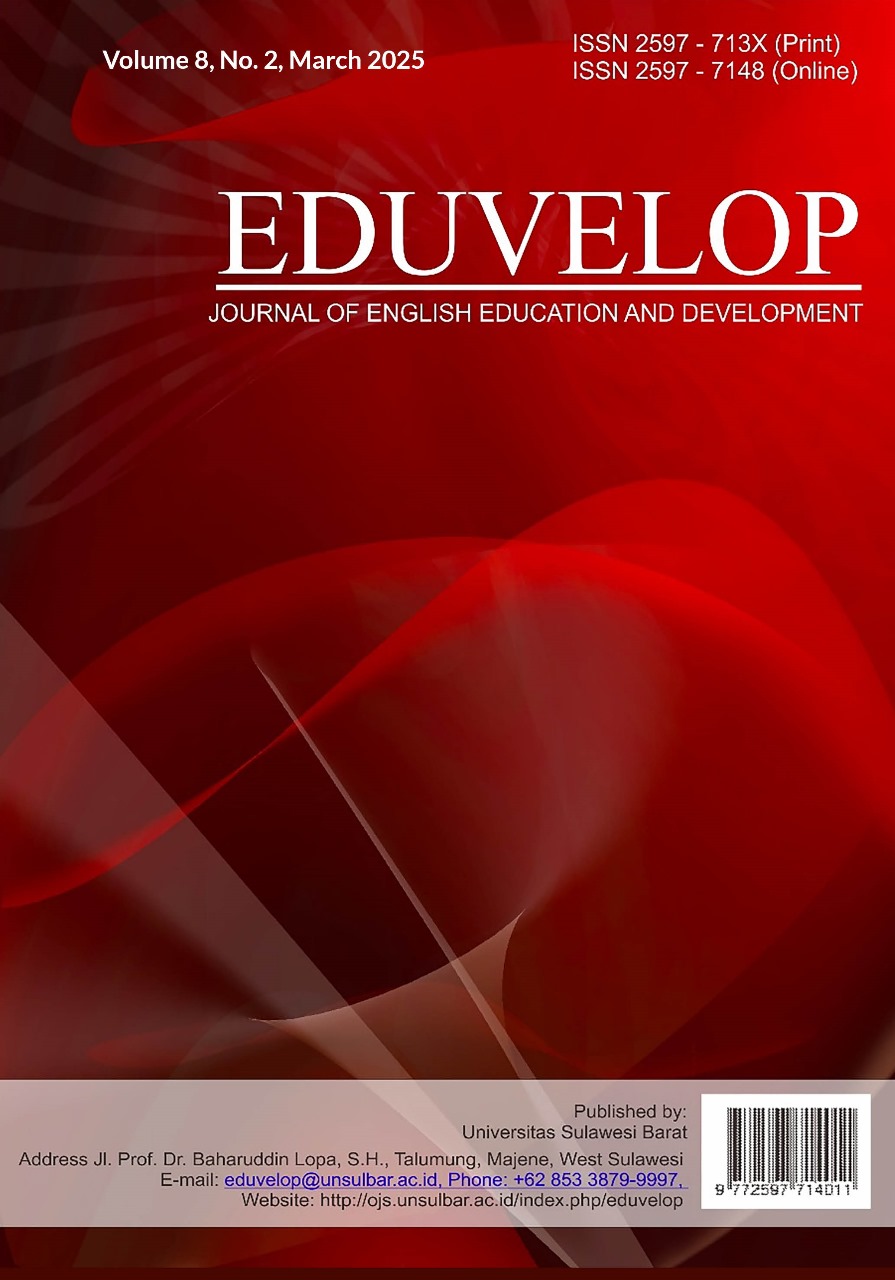Main Article Content
Abstract
This study aims to improve student learning outcomes through the implementation of peer tutoring-based cooperative learning. The research employs classroom action research with a total of 27 students involved in two cycles of learning. The cooperative model applied uses the STAD (Student Teams Achievement Division) type. Each cycle consists of three meetings and one final test at the end of the cycle. The results indicate that in the first cycle, the percentage of students achieving mastery in learning outcomes was 59.26%, which significantly increased to 100% in the second cycle. The research process involves stages of planning, action, observation, and reflection to ensure smoothness and effectiveness in implementing the teaching method. Overall, this study concludes that peer tutoring-based cooperative learning can be effectively applied to enhance student performance and suggests continuing similar research in different contexts regarding materials and educational levels to broaden the generalization of results.
Keywords
Article Details

This work is licensed under a Creative Commons Attribution 4.0 International License.
References
- Afriani, R. (2020). Teacher perception towards the use of code switching in EFL classroom: A case study in English intensive program at State Islamic Institute in Cirebon. Berumpun: International Journal of Social, Politics, and Humanities, 3(1), 1–12. https://doi.org/10.33019/berumpun.v3i1.22
- Alrajafi, G. (2021). The use of English in Indonesia: Status and influence. SIGEH ELT: Journal of Literature and Linguistics, 1(1), 1–10. https://doi.org/10.36269/sigeh.v1i1.355
- Ansar, F. A. (2017). Code switching and code mixing in teaching-learning process. Jurnal Tadris Bahasa Inggris, 10(1), 29–45.
- Astrid, A. (2022). How to design a research proposal. CV Insan Cendikia.
- Benu, N. N. (2018). Code switching in EFL classroom (A case study at a state senior high school in Kupang). Exposure: Jurnal Pendidikan Bahasa Inggris, 7(2), 150–160. https://doi.org/10.26618/exposure.v7i2.150
- Bonyadi, A., Kalvanagh, M. K., & Bonyadi, M. (2021). Teachers’ perceptions on code-switching in EFL classroom discourse. Discourse and Communication for Sustainable Education, 12(2), 45–53. https://doi.org/10.2478/dcse-2021-0015
- Cahyani, H., de Courcy, M., & Barnett, J. (2018). Teachers’ code-switching in bilingual classrooms: Exploring pedagogical and sociocultural functions. International Journal of Bilingual Education and Bilingualism, 21(4), 465–479. https://doi.org/10.1080/13670050.2016.1189509
- Creswell, J. W. (2012). Educational research: Planning, conducting, and evaluating quantitative and qualitative research (4th ed.). Pearson Education.
- Creswell, J. W. (2013). Qualitative inquiry & research design choosing among five approaches (3rd ed.). Sage Publication, Inc.
- Emilda, H., Safnil, S., & Maisarah, I. (2021). An analysis of Islamic senior high school English teacher’s perception of using code switching in the classsroom English teaching. Edu-Ling: Journal of English Education and Linguistics, 5(1), 52–64. https://doi.org/10.32663/edu-ling.v5i1.2460
- Etikan, I. (2016). Comparison of convenience sampling and purposive sampling. American Journal of Theoretical and Applied Statistics, 5(1), 1–4. https://doi.org/10.11648/j.ajtas.20160501.11
- Horasan, S. (2014). Code-switching in EFL classrooms and the perceptions of the students and teachers. Journal of Language and Linguistic Studies, 10(1), 31–45.
- Istifci, I. (2019). Code-switching in tertiary level EFL classrooms: Perceptions of teachers. Journal of Language and Linguistic Studies, 15(4), 1287–1299. www.jlls.org
- Istiqomah, F. (2016). Reintroducing the importance of teaching English at primary schools in Indonesia. Jurnal Bahasa Lingua Scientia, 8(1), 15–20. https://doi.org/10.21274/ls.2016.8.1.23-30
- Juliadnyana, I. G., Suarnajaya, I. W., & Ramendra, D. P. (2020). The analysis of teachers’ code switchings based on the perceptions of the eighth-grade students of SMP Negeri 2 Sawan. Journal of Education Research and Evaluation, 4(2), 158–164. https://doi.org/10.23887/jere.v4i2.24919
- Leoanak, S. P. P., & Amalo, B. K. (2018). Teachers’ beliefs and perceptions of code switching in English as foreign language classroom. SHS Web of Conferences, 42(1), 1–6. https://doi.org/10.1051/shsconf/20184200034
- Mahdi, A., & Almalki, M. S. (2019). Teachers’ perceptions towards pedagogical implications of code switching: Saudi EFL classroom context in focus. International Journal on Studies in English Language and Literature, 7(3), 1–9. https://doi.org/10.20431/2347-3134.0703001
- Mattsson, A. F., & Barenhult, N. (1999). Code-Switching in Second Language Teaching of French. Working Papers: Lund University, 47, 59–72.
- Nithideechaiwarachok, B., Maneekanon, O., & Bubphada, T. (2022). Exploring English language proficiency, English language problems, and English needs among first year undergraduate students. International Journal of Learning, Teaching and Educational Research, 21(12), 273–290. https://doi.org/10.26803/ijlter.21.12.15
- Rao, P. S. (2019). The role of English as a global language. Research Journal of English, 4(1), 65–79. www.rjoe.org.in
- Ruslin, Mashuri, S., Sarib, M., Rasak, A., & Alhabsyi, F. (2022). Semi-structured interview: A methodological reflection on the development of a qualitative research instrument in educational studies. IOSR Journal of Research & Method in Education (IOSR-JRME), 12(1), 22–29. https://doi.org/10.9790/7388-1201052229
- Sastra, P. A. S., & Adriyanti, K. Y. (2022). English teachers’ perception and strategies towards the use of code-switching in teaching EFL young learners. Acitya: Journal of Teaching and Education, 4(1), 25–39. https://doi.org/10.30650/ajte.v4i1.2289
- Sert, O. (2005). The functions of code switching in ELT classrooms. The Internet TESL Journal, 9(8), 2–6.
- Suganda, L. A., Loeneto, B. A., & Zuraida, Z. (2018). Teachers’ use of code switching in an English as a foreign language context in Indonesia. Script Journal: Journal of Linguistic and English Teaching, 3(2), 111–126. https://doi.org/10.24903/sj.v3i2.202
- Upa’, R. (2014). Code switching types used by the English teacher in English classroom at SMA I Malili. Ethical Lingua, 1(2), 44–58.
- Wong, Y., & Yoong, D. (2019). ESL teachers’ perceptions and practices of code-switching in a Malaysian Chinese independent secondary school. Journal of Modern Languages, 29(1), 45–66. https://doi.org/10.22452/jml.vol29no1.3
- Zainil, Y., & Arsyad, S. (2021). Teachers’ perception of their code-switching practices in English as a foreign language classes: The results of stimulated recall interview and conversation analysis. SAGE Open, 11(2), 1–10. https://doi.org/10.1177/21582440211013802

